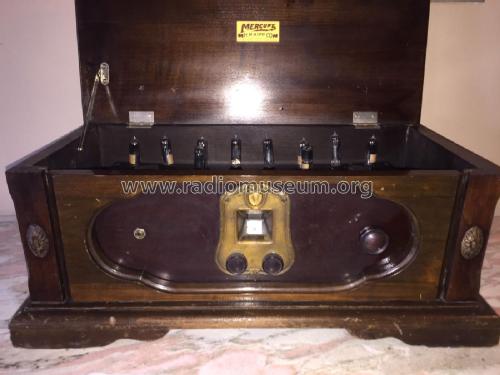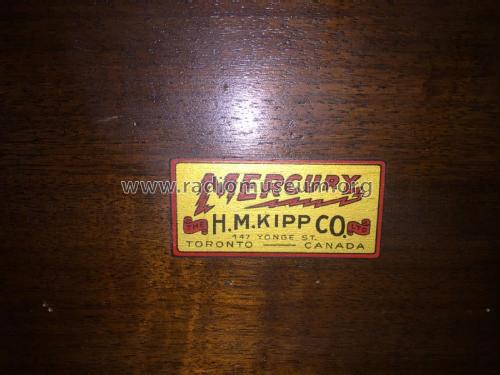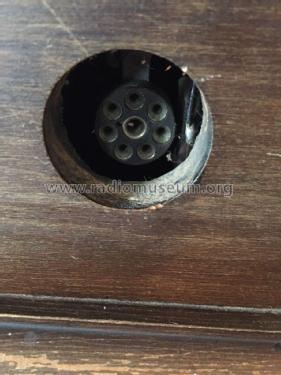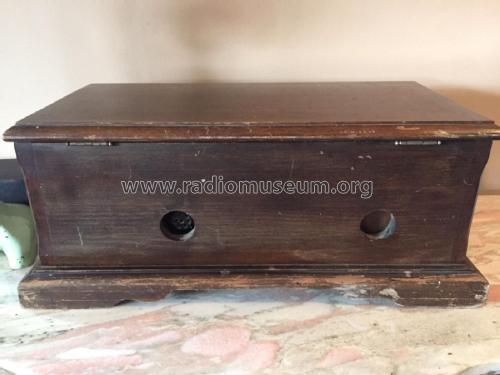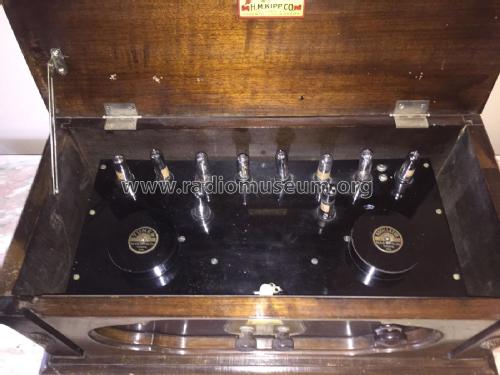Mercury Super Ten (DeLuxe Mercury Super 10 mahogany
Kipp Co. Ltd., H.M.; Toronto
- Pays
- Canada
- Fabricant / Marque
- Kipp Co. Ltd., H.M.; Toronto
- Année
- 1925–1927
- Catégorie
- Radio - ou tuner d'après la guerre 1939-45
- Radiomuseum.org ID
- 110169
- No. de tubes
- 10
- Principe général
- Super hétérodyne (en général); FI/IF 247 kHz
- Gammes d'ondes
- PO, GO et plus que 2 x OC
- Tension / type courant
- Piles (rechargeables ou/et sèches) / 6 & 60 to 135 Volt
- Haut-parleur
- - Ce modèle nécessite des HP externes
- Matière
- Boitier en bois
- De Radiomuseum.org
- Modèle: Mercury Super Ten (DeLuxe Mercury Super 10 [mahogany] - Kipp Co. Ltd., H.M.; Toronto
- Forme
- Modèle de table boitier avec vouvercle
- Remarques
- This version of the Super Ten is also known as the DeLuxe Mercury model.
It employed not less than 10 "Peanut" tubes - and the radio (included it's siblings) was touted as the most sensitive and selective radio in the mid 1920s. The tubes had cost an extra 30 CDN$. 4 stages of RF/IF, oscillator, 2 detectors, AF tube and 2 power output tubes. Series-parallel filament circuit for the 1.1 volt tubes on a 6 volt accumulator. Thanks to the R215A tubes the set consumes only 500 ma on the "A" battery and a max. of 20 ma on the "B" battery. If 60 volts are used no bias ("C" battery) is needed. The Mercury Super Ten has also been sold as a kit. Customers could buy a loop aerial model "A" for 23.50 CDN$, designed for the Mercury Super Ten. Several prizes were awarded to the Mercury Super Ten (Super 10) for its excellent reception properties.
You can differenciate on the front of the wooden bottom if it is a Standard or a DeLuxe model case: The standard swings to the bottom in the middle and the DeLuxe mahogany is straight, the DeLuxe walnut swings upwards. The chassis of the Mercury DeLuxe shows vernier dials and the Standard comes with a "normal" dial. The RF and oscillator coils of the DeLuxe are plug-in coils (at either end), the Standard employs fixed coils. The Mercury Super Ten was made in Toronto at the beginning of 1925. According to Robert P. Murray in "The early development of Radio in Canada" (page 113) C.A. Lowry designed the receiver, a young engineering student. The cabinets were probably made in different places because some variations exist. The "peanut tubes" were designed as reliable telephone industry repeater tubes. Available were plug in coils for 9-22, 22-32, 32-80, 80-190, 190-550 meters and coils covering wavelengths up to 1000 meters.
- Auteur
- Modèle crée par Ernst Erb. Voir les propositions de modification pour les contributeurs supplémentaires.
- D'autres Modèles
-
Vous pourrez trouver sous ce lien 9 modèles d'appareils, 5 avec des images et 5 avec des schémas.
Tous les appareils de Kipp Co. Ltd., H.M.; Toronto
